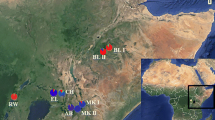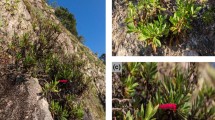Abstract
Complex and integrative approaches may be necessary to understand the abundant-centre model and the patterns in genetic diversity that may be explained by this model. Here we developed an integrated framework to study spatial patterns in genetic diversity within local populations, coupling genetic data, niche modelling and landscape genetics, and applied this framework to evaluate population structure of Caryocar brasiliense, an endemic tree from the Brazilian Cerrado. We showed different geographical patterns for genetic diversity, allelic richness and inbreeding levels, estimated using microsatellite data for ten local populations. Ecological suitability was estimating by combining five niche modelling techniques. Genetic diversity tend to follow a central-periphery model and is associated with ecological variables. On the other hand, inbreeding levels may be alternatively explained by isolation processes and habitat fragmentation more related to intense recent human occupation in the southern border of the biome, or by deeper historical patterns in the origin of the populations. Although still suffering from some of the problems of central-periphery analysis (small number of local populations), our analyses show how these patterns can be better investigated and offering a better understanding of the processes structuring genetic diversity within species’ geographic ranges.



Similar content being viewed by others
References
Alleaume-Benharira M, Pen IR, Ronce O (2006) Geographical patterns of adaptation within a species' range: interactions between drift and gene flow. J Evol Biol 19:203–215
Anderson RP, Martinez-Meyer E (2004) Modeling species' geographic distributions for preliminary conservation assessments: an implementation with the spiny pocket mice (Heteromys) of Ecuador. Biol Conserv 116:167–179
Araújo MB, Pearson RG (2005) Equilibrium of species’ distributions with climate. Ecography 28:693–695
Araújo MB, Guisan A (2006) Five (or so) challenges for species distribution modelling. J Biogeogr 33:1677–1688
Araújo MB, New M (2007) Ensemble forecasting of species distributions. Trends Ecol Evol 22:42–47
Avise JC (2004) Molecular markers, natural history and evolution. Sinauer Associates, Sunderland
Brown JH (1984) On the relationship between abundance and distribution of species. Am Nat 124:255–279
Caetano S, Prado D, Pennington RR, Oliveira-Filho A, Spichiger R, Naciri Y (2008) The history of seasonally dry tropical forests in eastern South America: inferences from the genetic structure of the tree Astronium urundeuva (Anacardiaceae). Mol Ecol 17:3147–3159
Collevatti RG, Brondani RPV, Grattapaglia D (1999) Development and characterization of microsatellite markers for genetic analysis of a Brazilian endangered species Caryocar brasiliense. Heredity 83:748–756
Collevatti RG, Grattapaglia D, Hay JD (2001) Population genetic structure of the endangered tropical tree species Caryocar brasiliense, based on variability at microsatellite loci. Mol Ecol 10:349–356
Collevatti RG, Grattapaglia D, Hay JD (2003) Evidences for multiple maternal lineage origin of Caryocar brasiliense populations in Brazilian Cerrado based on the analysis chloroplast DNA sequences and microsatellites haplotypes. Mol Ecol 12:105–115
Diniz-Filho JAF, Telles MPC (2002) Spatial autocorrelation analysis and the identification of operational units for conservation in continuous populations. Conserv Biol 16:924–935
Diniz-Filho JAF, Sant'ana CER, Bini LM (1998) An eigenvector method for estimating phylogenetic inertia. Evolution 52:1247–1262
Diniz-Filho JAF, Fuchs S, Arias MC (1999) Phylogeographic autocorrelation of phenotypic evolution in honey bees (Apis mellifera). Heredity 83:671–680
Diniz-Filho JAF, Bini LM, Hawkins BA (2003) Spatial autocorrelation and red herrings in geographical ecology. Global Ecol Biogeogr 12:53–64
Diniz-Filho JAF, Bini LM, Pinto MP, Rangel TFLVB, Carvalho P, Bastos RP (2006) Anuran species richness, complementarity and conservation conflicts in Brazilian Cerrado. Acta Oecol 29:9–15
Diniz-Filho JAF, Telles MPC, Bonatto SL et al (2008a) Mapping the evolutionary twilight zone: molecular markers, populations and geography. J Biogeogr 35:753–763
Diniz-Filho JAF, Rangel TFLVB, Bini LM (2008b) Model selection and information theory in geographical ecology. Global Ecol Biogeogr 17:479–488
Eckert CG, Samis KE, Lougheed SC (2008) Genetic variation across species' geographical ranges: the central-marginal hypothesis and beyond. Mol Ecol 17:1170–1188
Elith J, Graham CH, Anderson RP et al (2006) Novel methods improve prediction of species' distributions from occurrence data. Ecography 29:129–151
Excoffier L, Smouse PE, Quattro JM (1992) Analysis of molecular variance inferred from metric distances among DNA haplotypes: application to human mitochondrial DNA restriction data. Genetics 131:479–491
Farber O, Kadmon R (2003) Assessment of alternative approaches for bioclimatic modeling with special emphasis on the Mahalanobis distance. Ecol Model 160:115–130
Gaston KJ (2003) The structure and dynamics of geographic ranges. Oxford University Press, Oxford
Gaston KJ, Blackburn TM (2000) Pattern and process in macroecology. Blackwell, London
Ginzburg LR, Golenberg EM (1985) Lectures in theoretical population biology. Prentice-Hall, Englewood Cliffs
Hawkins BA, Diniz-Filho JAF, Bini LM, De Marco P, Blackburn TM (2007) Red herrings revisited: spatial autocorrelation and parameter estimation in geographical ecology. Ecography 30:375–384
Hijmans RJ, Guarino L, Bussink C, Barrantes I, Rojas E (2005) DIVA-GIS, Version 5.2. http://www.diva-gis.org (last accessed 14 July 2008)
Hoffman AA, Blows MW (1994) Species borders: ecological and evolutionary perspectives. Trends Ecol Evol 9:223–227
Holderegger R, Wagner HH (2006) A brief guide to landscape genetics. Landsc Ecol 21:793–796
Holt RD, Keit TH (2005) Species' borders: a unifying theme in ecology. Oikos 18:3–6
Howes BJ, Lougheed SC (2008) Genetic diversity across the range of a temperate lizard. J Biogeogr 35:1269–1278
Jakob SS, Ihlow A, Blattner FR (2007) Combined ecological niche modelling and molecular phylogeography revealed the evolutionary history of Hordeum marinum (Poaceae)—niche differentiation, loss of genetic diversity and speciation in Mediterranean Quaternary refugia. Mol Ecol 16:1713–1727
Kidd DM, Ritchie MG (2006) Phylogeographic information systems: putting the geography into phylogeography. J Biogeogr 33:1851–1865
Kirkpatrick M, Barton NH (1997) Evolution of a species' range. Am Nat 150:1–23
Klink CA, Moreira AG (2002) Past and current human occupation, and land use. In: Oliveira PS, Marquis RJ (eds) The Cerrados of Brazil. Columbia University Press, New York, pp 69–88
Klink CA, Machado RB (2005) Conservation of the Brazilian Cerrado. Conserv Biol 10:710–713
Knowles LL, Carstens BC, Keat ML (2007) Coupling genetic and ecological-niche models to examine how past population distributions contribute to divergence. Curr Biol 17:940–946
Ledru MP (2002) Late Quaternary history and evolution of the cerrados as revealed by palynological records. In: Oliveira PS, Marquis RJ (eds) The Cerrados of Brazil. Columbia University Press, New York, pp 35–50
Legendre P, Legendre L (1998) Numerical ecology. Elsevier, Amsterdam
Lenormand T (2002) Gene flow and the limits to natural selection. Trends Ecol Evol 17:183–189
Lobo JM, Jimenez-Valverde A, Real R (2008) AUC: a misleading measure of the performance of predictive distribution models. Global Ecol Biogeogr 17:145–151
Lönn M, Prentice HC (2002) Gene diversity and demographic turnover in central and peripheral populations of the perennial herb, Gypsophila fastigiata. Oikos 99:489–498
Luoto M, Poyry J, Heikkinen RK, Saarinen K (2005) Uncertainty of bioclimate envelope models based on the geographical distribution of species. Global Ecol Biogeogr 14:575–584
Manel S, Schwartz MK, Luikart G, Taberlet P (2003) Landscape genetics: combining landscape ecology and population genetics. Trends Ecol Evol 18:189–197
Manly BFJ (1985) The statistics of natural selection. Chapman & Hall, London
Maurer BA (1994) Geographical population analysis: tools for the analysis of biodiversity. Blackwell Scientific, Oxford
Oliveira-Filho AT, Ratter JA (2002) Vegetation physiognomies and woddy flora of the cerrado Biome. In: Oliveira PS, Marquis RJ (eds) The Cerrados of Brazil. Columbia University Press, New York, pp 91–120
Peterson AT (2001) Predicting species' geographical distribution based on ecological niche modelling. Condor 103:599–605
Phillips S, Dudík M (2008) Modeling of species distributions with Maxent: new extensions and a comprehensive evaluation. Ecography 190:231–259
Phillips SJ, Anderson RP, Schapire RE (2006) Maximum entropy modeling of species geographic distributions. Ecol Model . doi:10.1016/j.ecolmodel.2005.03.026
Rangel TFLVB, Diniz-Filho JAF, Bini LM (2006) Towards an integrated computational tool for spatial analysis in macroecology and biogeography. Global Ecol Biogeogr 15:321–327
Ratter JA, Bridgewater S, Ribeiro JF (2003) Analysis of the floristic compositionof the Brasilian Cerrado vegetation. III: comparison of the woody vegetation of 376 areas. Edinburgh J Bot 60:57–109
Sagarin RD, Gaines SD (2002) The ‘abundant centre’ distributions: to what extent is it a biogeographical rule? Ecol Lett 5:137–147
Sagarin RD, Gaines SD, Gaylord B (2006) Moving beyond assumptions to understand abundance distributions across the range of species. Trends Ecol Evol 21:524–530
Sanderson EW, Jaiteh M, Levy MA, Redford KH, Wannebo AV, Woolmer G (2002) The human footprint and the last of the wild. Bioscience 52:891–904
Sano EE, Rosa R, Brito JLS, Ferreira LG (2008) Mapeamento semidetalhado do uso da terra do Bioma Cerrado. Pesq Agropec Bras 43:153–156
Segurado P, Araújo MB (2004) A evaluation of methods for modelling species distributions. J Biogeogr 31:1555–1568
Soares TN, Chaves LJ, Telles MPC, Diniz-Filho JAF, Resende LV (2008) Landscape conservation genetics of Dipteryx alata (“baru” tree: Fabaceae) from Cerrado region of central Brazil. Genetica 132:9–19
Sokal RR, Rohlf FJ (1995) Biometry, 3rd edn. Freeman, San Francisco
Soulé M (1973) The epistasis cycle: a theory of marginal populations. Annu Rev Ecol Syst 4:165–187
Stockwell DRB, Peterson AT (2002) Effects of sample size on accuracy of species distribution models. Ecol Model 148:1–13
Telles MPC, Diniz-Filho JAF, Bastos RP, Soares TN, Guimarães LD, Lima LP (2007) Landscape genetics of Physalaemus cuvieri in Brazilian Cerrado: correspondence between population structure and patterns of human occupation and habitat loss. Biol Conserv 139:37–46
Toledo MB, Bush MA (2007) A mid-holocene environmental change in Amazonian savannas. J Biogeogr 34:1313–1326
Tsoar A, Allouche O, Steinitz O, Rotem D, Kadmon R (2007) A comparative evaluation of presence-only methods for modelling species distributions. Divers Distrib 13:397–405
Walter BMT, Guarino ESG (2006) Comparação do método de parcelas com o “levantamento rápido” para amostragem da vegetação arbórea do Cerrado sentido restrito. Acta Bot Braz 20:285–297
Acknowledgments
We thank an anonymous reviewer for useful suggestions that improved the manuscript and clarified our ideas about this issue. Our programme in conservation biogeography and molecular ecology in the Brazilian Cerrado is supported by a PRONEX project from CNPq/SECTEC-GO (Proc. No. 23234156) for establishing conservation priorities in the Cerrado region and by several grants and fellowships from CNPq, CAPES and FUNAPE-UFG. Cooperation between genetic laboratories of MPCT and RGC are supported by a PROCAD-NF/CAPES programme, whereas work by JAFDF, LMB and PDM on distribution modelling have been supported by BIOIMPACT project for evaluating effect of climate change in the Neotropics, coordinated by M. B. Araújo.
Author information
Authors and Affiliations
Corresponding author
Additional information
Communicated by A. Kremer.
Rights and permissions
About this article
Cite this article
Diniz-Filho, J.A.F., Nabout, J.C., Bini, L.M. et al. Niche modelling and landscape genetics of Caryocar brasiliense (“Pequi” tree: Caryocaraceae) in Brazilian Cerrado: an integrative approach for evaluating central–peripheral population patterns. Tree Genetics & Genomes 5, 617–627 (2009). https://doi.org/10.1007/s11295-009-0214-0
Received:
Revised:
Accepted:
Published:
Issue Date:
DOI: https://doi.org/10.1007/s11295-009-0214-0




